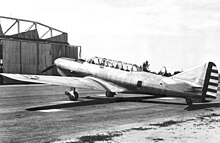Vultee A-19
| Vultee A-19 | |
|---|---|
 Vultee YA-19 during flight tests |
|
| Type: | Attack aircraft |
| Design country: | |
| Manufacturer: | |
| First flight: |
January 27, 1939 |
The Vultee A-19 was an American light bomber intended for close air support from Vultee Aircraft . The basis for the A-19 was the Vultee V-11, which was modified slightly for use with the United States Army Air Corps (USAAC) in order to collect data in comparison with light, twin-engine attack aircraft.
Design features and development
In the late 1930s, the USAAC preferred light, twin-engine aircraft for use in close air support. In the summer of 1938, however, seven pre-series YA-19 aircraft were ordered for comparative flight tests. The YA-19 was armed with six .30 caliber machine guns and could carry a bomb load of 1,080 pounds (around 490 kg) in the fuselage. It was powered by an air-cooled double radial engine Pratt & Whitney R-1830 Twin Wasp with an output of around 895 kW. The three-person crew consisted of a pilot, an observer / shooter and a bomb shooter / photographer. The first flight of the YA-19 took place on January 27, 1939.
An interesting feature of the YA-19 was that its horizontal stabilizer was mounted on the fuselage in front of the vertical stabilizer. The rudder unit was responsible for a directional instability because it was too small. The last YA-19 with the USAAC serial number 38-555 was therefore provided with an enlarged vertical stabilizer, but this did not finally solve the problem.
The comparative flight tests showed that a twin-engine aircraft could reach a higher speed and in doing so could accommodate a stronger armament and higher bomb load. No further YA-19s were then requested. After the comparative flight tests, however, the YA-19 received the regular designation A-19 and were briefly assigned to the 17th Attack Group on March Field in California.
Usage history
The 17th Attack Group was transferred to the Panama Canal Zone . There the A-11s were used for supply flights and as liaison aircraft. The A-19s never came into combat with the USAAC and were soon replaced by better models in the early 1940s.
Although the YA-19 did not get very far in the USA, the aircraft of the type were sold in relatively large numbers to other countries under the export designation Vultee V-11 . V-11 and V-12 were Vultee's in-house designations for their most popular aircraft types. Various models of the V-11 were sold to Brazil, China, Turkey and the Soviet Union. The V-12 (Model C and D) were sold to China.
The Chinese used the V-11/12 as a light bomber with some success. For example, a Japanese-occupied airfield near Yuncheng was bombed on February 5, 1939 by four V-11s of the 10th Squadron of the Republican Chinese Air Force. Subsequently, however, the aircraft were withdrawn from the front line and used for training purposes and as liaison aircraft during the 1940s.
variants
- YA-19
- Basic variant of the YA-19. Seven copies ordered, five delivered. Serial numbers: 38-549, 38-551 to 38-554.
- XA-19A
- The last ordered YA-19 (serial no. 38-555) was used as a test vehicle for engines under the designation XA-19A. She was powered by a Lycoming O-1230-1 and received an enlarged vertical tail. Later converted to the XA-19C. First flight May 22, 1940.
- XA-19B
- The second YA-19 (serial no. 38-550) was also used as a test vehicle for engines under the designation XA-19B. It was powered by a Pratt & Whitney R-2800 -1 radial engine with 1340 kW.
- XA-19C
- The XA-19A (serial number 38-555) received a Pratt & Whitney R-1830-51 and the designation XA-19C instead of the Lycoming engine . The performance was similar to the YA-19.
- A-19
- The remaining five YA-19s were renamed to A-19s when they went into active service.
operator
-
 Brazil : Vultee V-11
Brazil : Vultee V-11 -
 China : Vultee V-11 and Vultee V-12C / D
China : Vultee V-11 and Vultee V-12C / D -
 Soviet Union : Vultee V-11 (license designation BSch-1 and PS-43)
Soviet Union : Vultee V-11 (license designation BSch-1 and PS-43) -
 Turkey : Vultee V-11
Turkey : Vultee V-11 -
 United States
United States
Technical specifications
| Parameter | Data (YA-19) |
|---|---|
| crew | 3 |
| length | 11.53 m |
| span | 15.24 m |
| height | 3.05 m |
| Max. Takeoff mass | 4726 kg |
| Engine | a radial engine Pratt & Whitney R-1830 -17 895 kW (1,217 hp) |
| Top speed | 370 km / h |
| Max. Range | 2173 km |
| Summit height | 6250 m |
| Armament | four forward-facing Browning M1919 machine guns one rear-facing Browning M1919 machine gun, downward-facing machine gun 490 kg bomb payload |
Web links
- A-19 data from the US Air Force Museum


